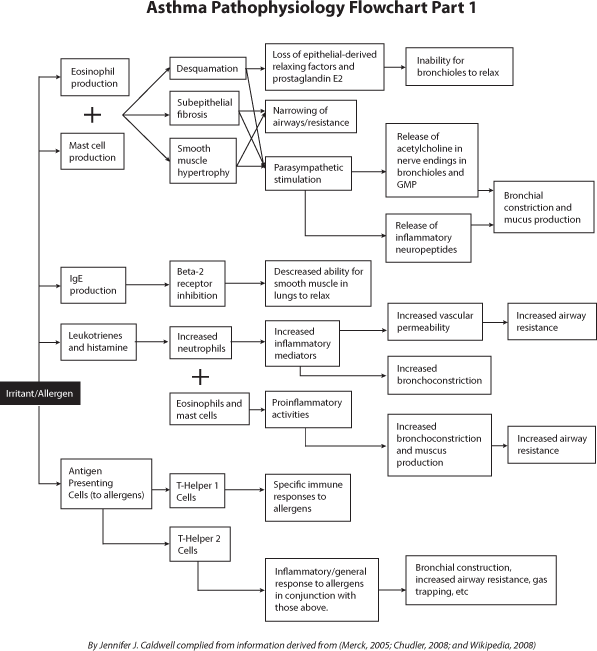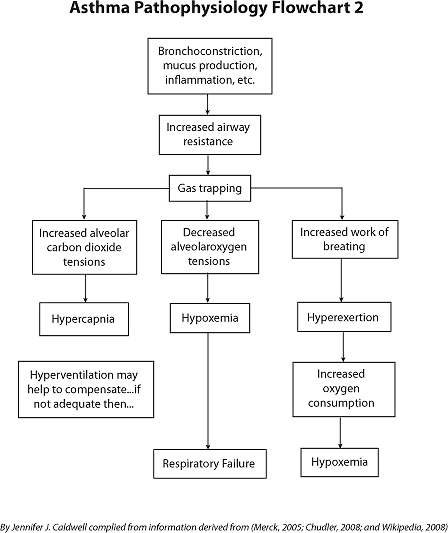Peak flow monitoring: Testing one’s peak flow at rest and after exercise can help the patient to determine the severity of reaction, especially in those with exercise-induced asthma (Wikipedia, 2008). Patients can monitor their peak expiratory flows at home with a hand-held spirometer (Merck, 2005).
A 20% or greater increase on a peak flow meter following treatment from 10 minutes of inhaled beta agonist, 6 weeks of inhaled corticosteroids, or 14 days of 30 mg of prednisone may suggest asthma. Also a 20% or greater decrease in peak flow following exposure to a certain trigger can be an indicator for asthma (Wikipedia, 2008).
Pulmonary function testing: Pulmonary function testing confirms and quantifies the severity and reversibility of airway obstruction. Bronchodilators should be stopped before the test, if possible, in order to get an accurate reading of the patient’s baseline. Spirometry should be obtained before and after inhaling a short-acting bronchodilator. Signs of airway obstruction before bronchodilator use include reduced forced expiratory volume in the first second (FEV1), and reduced ratio of FEV1 to forced vital capacity (FVC) which is read as FEV1/FVC. The FVC itself may also be decreased. Due to lung trapping, asthmatics may have reduced lung volume measurements. If the patient has an improvement of their FEV1 of greater than 12% or 0.2 L after inhaling a bronchodilator, this confirms reversible airway obstruction (Merck, 2005).
Flow volume loops can be used to diagnose or eliminate the possibility of vocal cord dysfunction which may cause upper airway obstruction that can mimic asthma with reduced ability to draw deep breaths, initiation of a cough, or wheezing (Merck, 2005).
A methacholine challenge test is often used to provoke bronchoconstriction in those who are still suspected of having asthma, but have normal spirometry, normal flow-volume loops, and who have no contraindications for the procedure. Contraindications include those patients who have an FEV1 loess than 1 L or less than 50%, a recent MI or stroke, and severe hypertension (systolic blood pressure greater than 200, diastolic greater than 100). A decrease in the patient’s FEV1 of greater than 20% indicates the patient has asthma. COPD needs to be ruled out as it will also cause similar response to this test as asthma (Merck, 2005).
Other testing: Other testing for asthma may include DLCO testing (diffusing capacity for carbon monoxide) which can help to distinguish it from COPD. In asthma, these levels are elevated and in COPD they are usually decreased, especially if the patient has emphysema (Merck, 2005).
A chest x-ray may rule out heart failure or pneumonia as alternative diagnoses. A chest x-ray in an asthmatic patient is usually normal or shows evidence of hyperinflation or segmental atelectasis (secondary to mucus plugging). If the patient has infiltrates on their x-ray, this may indicate allergic bronchopulmonary aspergillosis (Merck, 2005).
Allergy testing is indicated for those who have a suggestion of allergic stimuli/triggers. Children are potentially eligible for immunotherapy, and adults and children can be more aware of their triggering factors. Anti-IgE antibody therapy may be useful in patients with certain allergic responses. Both skin testing and radioallergosorbent testing (RAST) can identify allergic triggers. Elevated serum eosinophils (greater than 400 cells/µL and nonspecific IgE (greater than 150 international units) may suggest allergic asthma (Merck, 2005).
Large eosinophil counts in sputum is suggestive of asthma, but is no longer practiced because it is not sensitive or specific to the disease (Merck, 2005).




